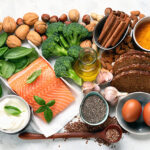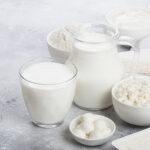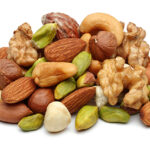What’s new?
Diabetes: We are in it together.
Living in a household implies sharing duties and responsibilities but it could also imply sharing your diabetes. A research team from the McGill University Health Centre has shown, through combined analyses of several studies, evidence that spousal diabetes is a diabetes risk factor. These findings, in BMC Medicine, have important clinical implications since they can help improve diabetes detection and motivate couples to work together to reduce the risk of developing the condition. ‘We found a 26% increase in the risk of developing type 2 diabetes if your spouse also has type 2 diabetes,’ says senior author of the study, Dr. Kaberi Dasgupta. ‘Changing health behaviour is challenging and if you have the collaboration of your partner it’s likely to be easier.’

Looks like it was too many calories after all.
‘O stop, stop. This is too much!’ cried the Mole in ecstacies on hearing that Rat’s fat, wicker luncheon-basket was packed with cold chicken plus ‘coldtongue-coldham-coldbeef-pickledgherkinssalad-frenchrolls-cresssandwiches-pottedmeat-gingerbeer-lemonade-sodawater’ And from Trevor J Carden and Timothy P Carr’s analysis in Nutrition Journal using USDA loss-adjusted food availability data, too much is what many of us have been eating. They report that total energy availability in the US food supply increased 10.7% from 1970 to 2009.
The findings are based on the U.S. Department of Agriculture’s Loss-Adjusted Food Availability Database and its Nutrition Database for Standard Reference. Those resources, rich in data about Americans’ eating patterns over the years, show that the energy (calories) available from protein, carbohydrates and fat increased 4.7 percent, 9.8 percent and 14.6 percent, respectively. ‘It is a misconception that fructose is a unique contributor to obesity,’ said Carr, who chairs UNL’s Department of Nutrition and Health Sciences. ‘Fructose turns out to be a relatively small contributor to the overall food supply.’ In 1970, fructose availability was 63.2 grams per day. It has fluctuated in the years since, but stood at 62.4 grams in 2009. ‘We conclude that increased total energy intake, due to increased availability of foods providing glucose (primarily as a starch in grains) and fat to be a significant contributor to increased obesity in the U.S.’
From 1970 to 1999, they found carbohydrate made the greatest contribution to the increased energy availability of the US diet, whereas the fats/oils category was a more important contributor to the energy increase after 1999. ‘This apparent replacement of carbohydrate with fats/oils may have been due to increasing popularity of diets lower in carbohydrate and higher in fat, thus accounting for the greater net accumulation of energy from fat versus carbohydrate.’
Does substantial progressive weight gain precipitate type 2 diabetes?
This is a common notion, but a small prospective cohort study in PLOS Medicine suggests it is possibly more complex. Dorte Vistisen and Kristine Færc and colleagues analyzed data from participants of the Whitehall II cohort, a group of London-based civil servants who have been followed for more than a decade, to see what changes in body weight and other parameters had occurred in people in the years before they were diagnosed with diabetes. 6,705 participants were free of diabetes when they entered the study and are included in the analysis. They were tested for diabetes every 5 years, and 645 of them were subsequently diagnosed with the disease. Going back to measurements of body mass index which were recorded regularly, the researchers used a statistical method to identify patterns of change in BMI among individuals who went on to develop diabetes. They identified three very clear groups in 632 of the participants with diabetes:
- 606 participants were ‘stably overweight’, and showed little change in their BMI over the years before they were diagnosed with diabetes.
- 26 participants were persistently obese for the entire time they participated in the study, in some cases for 18 years before they developed diabetes.
- 15 participants had gained weight continuously in the years before diagnosis.
Because the three distinct patterns of obesity development were accompanied by different changes over time in insulin resistance and other risk factors for heart disease and diabetes, the authors conclude that ‘type 2 diabetes is a not a single disease entity.’
Bush food is really, really good.
# Long yam. In the second of the thirty short films being made by Darwin-based record company Skinnyfish with Indigenous musicians to spread health messages in remote communities, a child shows us a long yam (Dioscorea transversa), one of the traditional staples Indigenous women have gathered for thousands of years in The Top End. Long yam is nutrient dense and a good source of fibre, vitamins and minerals. It is also has a low GI value (GI 37) making it a very good choice of starchy carbohydrate for people with diabetes or pre-diabetes who need to manage their blood glucose levels. You can view ‘Bush Food Is Really, Really Good’ HERE.
Sweet potatoes (Ipomoea batatas), are commonly called a yam in the US and Canada, but botanically they aren’t yams at all. They are the tuberous roots of a vine from the morning glory family (Convolvulaceae) and the varieties tested so far have moderate (GI 61) and high GI values (GI 75).
# Why bush food is really, really good. In the 1980s, Professor Jennie Brand-Miller analysed the nutrient composition of Aboriginal bush foods. ‘We looked at the protein, carbohydrate, fat and fibre content and built a database of the Indigenous diet,’ she says. ‘We also found that many of the foods tended to be low GI.’ when she and her co-authors published the results in the American Journal of Clinical Nutrition, they made the point that their findings ‘are consistent with the hypothesis that carbohydrate in traditional diets is slowly digested and absorbed and may once have been protective against diabetes’.

# Living off bush food back in 1948. Having Tables of composition of Australian Aboriginal foods is not the same as having actual nutritional detail about typical traditional diets. The first major study was in 1948, when Margaret McArthur and her colleagues observed the daily activities of families of nomadic Aborigines in Groote Eylandt, Bickerton Island, Port Bradshaw, Yirrkala and Oenpelli, Northern Territory over several months.
Discussing their findings in Nutrition studies (1948) of nomadic Aborigines in Arnhem Land, northern Australia they write: ‘It is not known to what extent these observations reflect conditions which prevailed before the traditional way of life of the Aborigines was disturbed by Europeans. The normal food intake of Aboriginal communities was never a constant quantity. Living as they did from the natural products of the country through which they moved, they had little control over the supply of food, which varied from season to season and from year to year. Nevertheless, the Aborigines did not wander aimlessly about the countryside looking for food. As is evident from this study, they applied knowledge and skills accumulated over countless centuries. The women knew the ecosystems in which food was to be found and the type of food they would find in each; the men knew when and where to hunt game, fish and turtle … With only a few exceptions, the diets which were recorded at four camps in Arnhem Land – from the beginning to the end of the dry season of the monsoonal climate – were well balanced in protein, fat, carbohydrate and crude fibre, and were comparable to international dietary recommendations in energy, iron, calcium and ascorbic acid.’
New GI values.
Corn syrup (dark) Here we are talking about the regular corn syrup that is very popular in the US, not high fructose corn syrup. It is about half as sweet as regular granulated sugar but it has the same number of calories per level teaspoon = 16 (= 67 kilojoules).
- Glycemic index = 90
- Available carbohydrate per level teaspoon = 4g
- Glycemic load per 1 level teaspoon = 4
- Glycemic load per 1 level 15-ml tablespoon = 11
- Glycemic load per 1 level Australian 20-ml tablespoon = 14
Perspectives.
How farming reshaped our genomes
David Katz questions recent epidemiologic study on sugar
Sweet and sour: The media decided fructose was bad for America; but science had second thoughts
Gregory Hand asks the question: If fast food is addictive, cheap and available and almost all of us eat it, then why aren’t we all obese?








